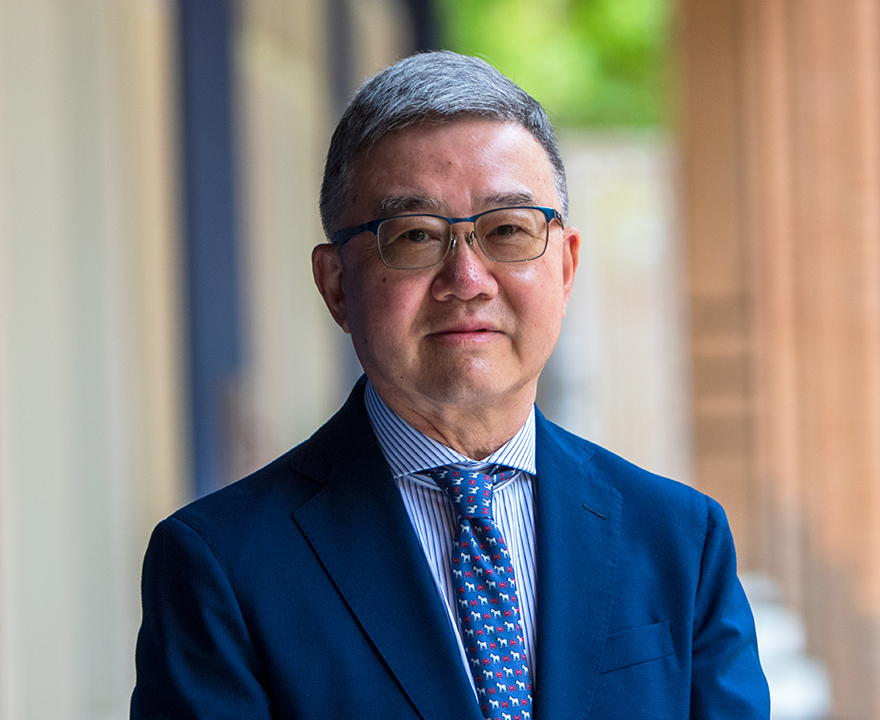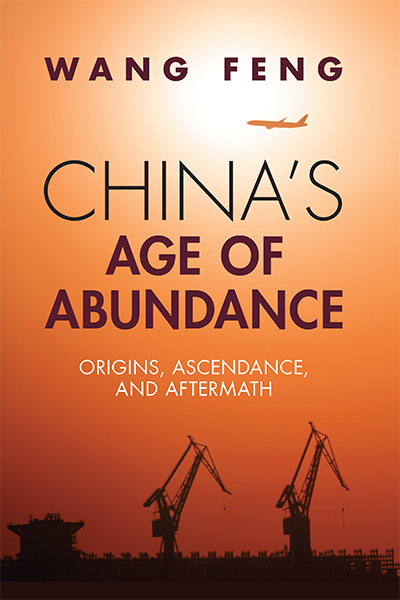
China’s Age of Abundance: Origins, Ascendance, and Aftermath
 In his new book, China’s Age of Abundance: Origins, Ascendance, and Aftermath (Cambridge University Press), UCI sociologist and acclaimed population scientist
Wang Feng explores the lesser-studied grassroots origins of China's path to prosperity.
Focusing on the critical role of low income, rural populations in the country's rise
as an economic and political powerhouse, he takes us through the decades to China's
present-day predicament marked by an aging population, increasing inequality, and
intensifying political control. Below, the award-winning professor shares his expertise
on China's shifting narrative, economic trajectory, and other hurdles on the horizon.
In his new book, China’s Age of Abundance: Origins, Ascendance, and Aftermath (Cambridge University Press), UCI sociologist and acclaimed population scientist
Wang Feng explores the lesser-studied grassroots origins of China's path to prosperity.
Focusing on the critical role of low income, rural populations in the country's rise
as an economic and political powerhouse, he takes us through the decades to China's
present-day predicament marked by an aging population, increasing inequality, and
intensifying political control. Below, the award-winning professor shares his expertise
on China's shifting narrative, economic trajectory, and other hurdles on the horizon.
Q: Beginning in the 1980s, China has emerged as an economic and political powerhouse. What defining factors have fueled this shift?
A: China's extraordinary economic boom over the past four and a half decades is not just a tale of reforms and global integration, as commonly told. My journey in writing this book challenged the prevailing narrative that often oversimplifies China's ascent to prosperity, portraying it as a predetermined path guided solely by the government.
In the pages of my book, I sought to uncover the lesser-explored grassroots origins that underlie the profound economic transformation we've witnessed. While institutional reforms and global connections played crucial roles, what truly fueled China's economic rise was the remarkable energy and ingenuity of its people. My research emphasizes that the government didn't create this intrinsic energy; rather, reforms and openness merely unleashed the latent potential.
As I delved into the late 1970s, when China teetered on the edge of economic takeoff, it became evident that the fervent desire to improve living standards was palpable among the vast population, especially the 80% residing in rural areas. This journey towards material abundance unfolded through three transformative phases — private farming in the 1980s, rural industrialization in the 1990s, and the surge of rural-to-urban migration from the 1990s onward. What's remarkable is that none of these shifts were instigated by the state; they sprang from the unwavering aspirations of the people, initially met with resistance from the government before gaining acceptance.
Reflecting on China's path to prosperity, I found a narrative that mirrors the trajectory of other industrialized economies but carries its unique Chinese characteristics. It's not just about cheap labor, as commonly portrayed; it's about the affordability of labor within the Chinese social system. Unfortunately, this system treated the rural-origin population as secondary citizens within their own nation, a poignant aspect that shapes China's distinctive journey to material abundance.
Q: Your work homes in on the role low income, rural populations have played in driving China’s economic growth. What changes helped bring this segment into China’s narrative, and at what cost?
A: On the cusp of China's economic takeoff, a moment that would reshape countless lives, I couldn't help but reflect on the startling reality faced by over one-fifth of the world's population within China. Despite being healthy and literate, they teetered on the verge of subsistence. It was a poignant time, with memories of collective farming from the 1950s to the late 1970s lingering. I vividly recall urban residents facing the stark reality of reduced meat rationing, a mere 0.25 kg per month by the late 1970s, while farmers, with dreams held in their hearts, had less than one egg to savor each month. In the late 1970s, on average, only one in three rural resident could afford just one pair of shoes for an entire year.
Then came the transformative return to household farming, a grassroots movement initiated by farmers themselves. The results were awe-inspiring — a remarkable 25 percent increase in grain output in just five years between 1978 and 1983. It wasn't just about numbers; it was about the taste of progress, with per capita egg consumption rising by 50 percent, pork by 61 percent, vegetable oil by 151 percent, and poultry by a staggering 268 percent, all in just short five years.
As I delve into the mid-1990s, a period where the state sector in urban areas was in deep trouble, I'm struck by the resilience of rural areas. Township and village enterprises emerged as the unsung heroes, driving China's export-oriented economy. Imagine the bustling life in rural enterprises that employed 164 million people by 1995, surpassing the total number of employees in state and collectively owned enterprises combined.
The third phase, the era of rural-to-urban migration, became a tidal wave of change. Picture the masses leaving the countryside, seeking new horizons in the city. By 2018, a staggering 241 million people, almost one-fifth of China's population, became the backbone of urban development. These migrants, with dreams in their eyes, crafted China's city skylines, built highways, bridges, and airports, assembled iPhones, and manufactured clothes and shoes. In 2015, China exported a staggering 3.5 billion pairs of shoes, enough to touch the lives of more than half the world's population outside China.
Yet, as I unveil these layers of progress, the personal stories of migrant laborers come into focus. They bore the weight of China's prosperity on their shoulders. The unique socialist legacy, adopting a "one-country, two systems" approach, created a stark division between urban and rural populations. I can't help but empathize with the challenges faced by these migrants—long working hours, meager pay, limited benefits, and the heart-wrenching decision to leave their children behind in villages. As urban residents reaped the rewards of surging real estate prices, migrants often found such opportunities elusive. The invaluable labor of these migrants, made affordable by Chinese social institutions, echoed across the global landscape, enriching capitalists but leaving many of these unsung heroes on the fringes of prosperity.
Q: Your book touches on some of the challenges – such as an aging population, increasing inequality, and intensifying political control – that China faces going forward. How do you foresee these factors impacting China’s economic preeminence, and do you believe they signify the end of the 'Age of Abundance'?
A: As I ponder China's economic trajectory, I find myself drawing parallels to the experiences of its neighbors, Japan and South Korea. I can't help but reflect on their per capita income surging at a remarkable 10 percent or more annually as their urban population share rose from 30 to 75 percent. China, too, underwent a comparable journey between 1990 and 2020, with per capita income expanding at over 10 percent annually as its urban population share climbed from below 30 percent to nearly 70 percent. Yet, like Japan and South Korea, China faced a substantial slowdown in income growth post its economic boom.
The echoes of economic patterns are unmistakable. Japan's growth rate plummeted to an average of 1.45 percent annually after 1980, and South Korea to 2.85 percent after 2001. In the 2010s, even before the global pandemic, China observed a decline in GDP per capita growth from 10 percent in 2010 to below 6 percent in 2019. It's evident — the era of China's abundance, marked by hyper-growth and a rapid rise in living standards, has come to a close.
However, it's not just about economic shifts; it's about the societal challenges that accompany them. China, now an upper-middle-income country, grapples with a unique set of hurdles. I can't help but feel the weight of four decades of hyper growth resulting in a highly unequal society — economic inequality escalating from income to wealth. Despite a per capita income still one-quarter of the United States', China has become home to a comparable number of billionaires in just a couple of decades, earning a reputation as one of the world's most unequal societies. Unlike the United States, where wealth accumulation and inequality took decades, if not centuries, China achieved this level of inequality within a relatively short period.
Then, there's the human side of the story. Over 200 million rural migrants await integration into urban areas, facing a society rapidly aging and a three-decade-long one-child policy resulting in a multitude of single-child families. The challenges ahead are not just fiscal but deeply personal — the inevitable rise in pension and health care costs poses challenges to the government, depleting the surplus accrued during the boom years.
China's entry into an era of abundance was not just a statistical shift but a testament to a fortuitous alignment of historical conditions. It was about a healthy, literate, and industrious population eager to transition from farmland, a reshaping of perceptions of the Communist Party in the wake of the tumultuous Cultural Revolution, and the visionary leadership of Deng Xiaoping, who guided China away from a planned economy. As four decades of rapid economic growth uplifted the lives of a fifth of humanity, it also bred complacency and hubris, diverting China from global engagement and potentially hindering its continued march toward prosperity. It's not just about economic graphs; it's about the collective journey and the human narratives embedded within.


